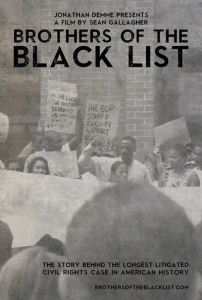Cady Kuzmich, News Editor

Trudging through the snow, I decided to take refuge in the news office – a room typically bustling but at times dark and empty. With an hour to kill before a State Times meeting I decided to poke around the news desk – one used by many news editors before my time. Rummaging through the old wooden drawers, I came across a thick yellow envelope with the words “The Blacklist File” scrawled in black Sharpie ink. Naturally curious as to what my predecessors had decided to save in this file, I pulled it out and started digging through old newspaper clippings from 1992, 1994, 1995 and 2004. Besides newspaper clippings and notes for news articles, the folder held thick stacks of papers from court proceedings. Repeatedly, this list kept appearing in campus, town and state news for over a decade.
For those of you who may not know what the blacklist is all about, I’ll give you a brief run-down of events. According to a New York Times article from 1992, an elderly white woman was attacked in the early hours of the morning of September 4 in Oneonta. The only description the woman could give of her attacker was that she thought he was a black man and that he would have cut marks on his hands since she cut him while trying to defend herself. Based on this description, the school generated a list of all black and Hispanic males registered at SUNY Oneonta. The police used the list to track down the potential suspects in their “dormitories, at their jobs and in the shower.” Outraged, students took to the quad in protest and the men on the blacklist brought the school to court. The Vice President of the College was forced to take an unpaid leave of absence and was demoted (and then promoted four years later once students who had experienced the blacklist firsthand had graduated).
At what point do we stop hiding from our mistakes and accept what they can teach us? Protests and trials didn’t give the college the option to ignore its mistake. 22 years later, the list feels like a distant shameful mark on our college’s history. While the school has brought speakers in to talk to students about the blacklist, it may be hard for current students to really connect with the event and the outrage felt by past students.
Now that time has passed, it has become safe, even beneficial for the college to own up to its mistakes and give presentations on how far we have come towards accepting diversity and suppressing racism in this quiet upstate New York town. The Africana and Latino Studies Department recently sponsored a screening of “Brothers of the Blacklist,” a documentary directed and produced by Sean Gallagher, a SUNY Oneonta graduate (2008). The documentary will also be a part of the Africa World Film Festival. The college has no choice but to face the facts. Students past and present have made sure of that by continuing to push administrators’ faces up to the mirror.
Leave a Reply